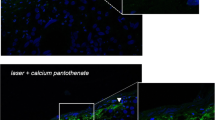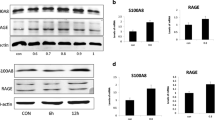Abstract
The aim of this study was to investigate the role of transforming growth factor β1 in mechanisms of cutaneous remodeling induced by fractional carbon dioxide laser treatment. The dorsal skin of Kunming mice was exposed to a single-pass fractional CO2 laser treatment. Biopsies were taken at 1 h and at 1, 3, 7, 14, 21, 28, and 56 days after treatment. Transforming growth factor (TGF) β1 expression in skin samples was evaluated by ELISA, dermal thickness by hematoxylin–eosin staining, collagen and elastic fibers by Ponceau S and Victoria blue double staining, and types I and III collagens by ELISA. The level of TGF β1 in the laser-treated areas of skin was significantly increased compared with that in the control areas on days 1 (p < 0.05), 3 (p < 0.01), and 7 (p < 0.05) and then decreased by day 14 after treatment, at which time it had returned to the baseline level. Dermal thickness and the amount of type I collagen of the skin of the laser-treated areas had increased significantly (p < 0.05) compared with that in control areas on days 28 and 56. Fibroblast proliferation showed a positive correlation with TGF β1 expression during the early stages (r = 0.789, p < 0.01), and there was a negative correlation between the level of TGF β1 and type I collagen in the late stages, after laser treatment (r = −0.546, p < 0.05). TGF β1 appears to be an important factor in fractional laser resurfacing.


Similar content being viewed by others
References
Manstein D, Herron GS, Sink RK, Tanner H, Anderson RR (2004) Fractional photothermolysis: a new concept for cutaneous remodeling using microscopic patterns of thermal injury. Lasers Surg Med 34(5):426–438
Hantash BM, Bedi VP, Sudireddy V, Struck SK, Herron GS, Chan KF (2006) Laser-induced transepidermal elimination of dermal content by fractional photothermolysis. J Biomed Opt 11(4):041115
Hantash BM, Bedi VP, Chan KF, Zachary CB (2007) Ex vivo histological characterization of a novel ablative fractional resurfacing device. Lasers Surg Med 39(2):87–95
Tierney EP, Hanke CW, Petersen J (2012) Ablative fractionated CO2 laser treatment of photoaging: a clinical and histologic study. Dermatol Surg 38(11):1777–1789
Tierney EP, Hanke CW (2011) Fractionated carbon dioxide laser treatment of photoaging: prospective study in 45 patients and review of the literature. Dermatol Surg 37(9):1279–1290
Alexiades-Armenaka M, Sarnoff D, Gotkin R, Sadick N (2011) Multi-center clinical study and review of fractional ablative CO2 laser resurfacing for the treatment of rhytides, photoaging, scars and striae. J Drugs Dermatol 10(4):352–362
Barrientos S, Stojadinovic O, Golinko MS, Brem H, Tomic-Canic M (2008) Growth factors and cytokines in wound healing. Wound Repair Regen 16(5):585–601
Kopecki Z, Luchetti MM, Adams DH, Strudwick X, Mantamadiotis T, Stoppacciaro A, Gabrielli A, Ramsay RG, Cowin AJ (2007) Collagen loss and impaired wound healing is associated with c-Myb deficiency. J Pathol 211(3):351–361
Kane CJ, Hebda PA, Mansbridge JN, Hanawalt PC (1991) Direct evidence for spatial and temporal regulation of transforming growth factor beta 1 expression during cutaneous wound healing. J Cell Physiol 148(1):157–173
Riedel K, Riedel F, Goessler UR, Germann G, Sauerbier M (2007) TGF-beta antisense therapy increases angiogenic potential in human keratinocytes in vitro. Arch Med Res 38(1):45–51
Jiang X, Ge H, Zhou C, Chai X, Ren QS (2012) The role of vascular endothelial growth factor in fractional laser resurfacing with the carbon dioxide laser. Lasers Med Sci 27(3):599–606
Oue T, Puri P (1999) Abnormalities of elastin and elastic fibers in infantile hypertrophic pyloric stenosis. Pediatr Surg Int 15(8):540–542
Bogdan Allemann I, Kaufman J (2010) Fractional photothermolysis—an update. Lasers Med Sci 25(1):137–144
Baum CL, Arpey CJ (2005) Normal cutaneous wound healing: clinical correlation with cellular and molecular events. Dermatol Surg 31(6):674–686
Lee HS, Kooshesh F, Sauder DN, Kondo S (1997) Modulation of TGF-beta 1 production from human keratinocytes by UVB. Exp Dermatol 6(2):105–110
Wu L, Yu YL, Galiano RD, Roth SI, Mustoe TA (1997) Macrophage colony-stimulating factor accelerates wound healing and upregulates TGF-beta1 mRNA levels through tissue macrophages. J Surg Res 72(2):162–169
Rolfe KJ, Richardson J, Vigor C, Irvine LM, Grobbelaar AO, Linge C (2007) A role for TGF-beta1-induced cellular responses during wound healing of the non-scarring early human fetus? J Invest Dermatol 127(11):2656–2667
Liu W, Chua C, Wu X, Wang D, Ying D, Cui L, Cao Y (2005) Inhibiting scar formation in rat wounds by adenovirus-mediated overexpression of truncated TGF-beta receptor II. Plast Reconstr Surg 115(3):860–870
Clark RAF (1996) In: Clark RAF (ed) The molecular and cellular biology of wound repair, 2nd edn. Plenum, New York
Mazzieri R, Jurukovski V, Obata H, Sung J, Platt A, Annes E, Karaman-Jurukovska N, Gleizes PE, Rifkin DB (2005) Expression of truncated latent TGF-beta-binding protein modulates TGF-beta signaling. J Cell Sci 118:2177–2187
Sellheyer K, Bickenbach JR, Rothnagel JA, Bundman D, Longley MA, Krieg T, Roche NS, Roberts AB, Roop DR (1993) Inhibition of skin development by overexpression of transforming growth factor beta 1 in the epidermis of transgenic mice. Proc Natl Acad Sci U S A 90(11):5237–5241
Zambruno G, Marchisio PC, Marconi A, Vaschieri C, Melchiori A, Giannetti A, De Luca M (1995) Transforming growth factor-beta 1 modulates beta 1 and beta 5 integrin receptors and induces the de novo expression of the alpha v beta 6 heterodimer in normal human keratinocytes: implications for wound healing. J Cell Biol 129(3):853–865
Böttinger EP, Letterio JJ, Roberts AB (1997) Biology of TGF-beta in knockout and transgenic mouse models. Kidney Int 51(5):1355–1360
White LA, Mitchell TI, Brinckerhoff CE (2000) Transforming growth factor beta inhibitory element in the rabbit matrix metalloproteinase-1 (collagenase-1) gene functions as a repressor of constitutive transcription. Biochim Biophys Acta 1490(3):259–268
Papakonstantinou E, Aletras AJ, Roth M, Tamm M, Karakiulakis G (2003) Hypoxia modulates the effects of transforming growth factor-beta isoforms on matrix-formation by primary human lung fibroblasts. Cytokine 24:25–35
Yang L, Chan T, Demare J, Iwashina T, Ghahary A, Scott PG, Tredget EE (2001) Healing of burn wounds in transgenic mice overexpressing transforming growth factor-beta 1 in the epidermis. Am J Pathol 159(6):2147–2157
Adzick NS, Lorenz HP (1994) Cells, matrix, growth factors, and the surgeon. The biology of scarless fetal wound repair. Ann Surg 220(1):10–18
Silveira PC, Silva LA, Freitas TP, Latini A, Pinho RA (2011) Effects of low-power laser irradiation (LPLI) at different wavelengths and doses on oxidative stress and fibrogenesis parameters in an animal model of wound healing. Lasers Med Sci 26(1):125–131
Hakki SS, Bozkurt SB (2012) Effects of different setting of diode laser on the mRNA expression of growth factors and type I collagen of human gingival fibroblasts. Lasers Med Sci 27(2):325–331
Huang JS, Wang YH, Ling TY, Chuang SS, Johnson FE, Huang SS (2002) Synthetic TGF-beta antagonist accelerates wound healing and reduces scarring. FASEB J 16(10):1269–1270
Fujimura T, Takema Y, Moriwaki S, Tsukahara K, Imokawa G, Yamada A, Imayama S (2001) Analytical method to examine the effects of carbon dioxide lasers on skin: a study using wrinkles induced in hairless mice. Lasers Surg Med 28(4):348–354
Nowak KC, McCormack M, Koch RJ (2000) The effect of superpulsed carbon dioxide laser energy on keloid and normal dermal fibroblast secretion of growth factors: a serum-free study. Plast Reconstr Surg 105(6):2039–2048
Acknowledgments
We are grateful to Yuxiu Liu for her invaluable support with the aspects of histology in this study. The research was supported by the Chinese Postdoctoral Science Foundation (2013M531166), Postdoctoral Science Foundation of Shanghai Jiao Tong University (13X100030001), and Biomedical Engineering Foundation of Shanghai Jiao Tong University (Yu2011MS70).
Author information
Authors and Affiliations
Corresponding author
Rights and permissions
About this article
Cite this article
Jiang, X., Ge, H., Zhou, C. et al. The role of transforming growth factor β1 in fractional laser resurfacing with a carbon dioxide laser. Lasers Med Sci 29, 681–687 (2014). https://doi.org/10.1007/s10103-013-1383-5
Received:
Accepted:
Published:
Issue Date:
DOI: https://doi.org/10.1007/s10103-013-1383-5




